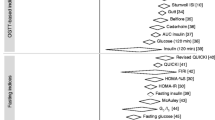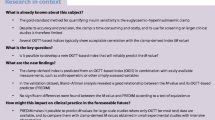Abstract
The gold standard for quantifying insulin sensitivity (IS) is the hyperinsulinemic-euglycemic clamp (Clamp) with a cut-off point of 5 × 10−2 (dL/min)/(µU/mL) or less to indicate insulin resistance. Bergman’s minimal model (Min-Mod) is also being used to estimate IS, but there are doubts as to its equivalence with Clamp. The objective of the present study is to determine if Clamp and the tolbutamide and insulin techniques of Min-Mod are equivalent. Meta-analysis based on a bibliographic search from 1970 until the present was made for the MeSH terms: insulin resistance, hyperglycemic-clamp, euglycemic-clamp, Min-Mod, minimal model approach. Concordance was determined with both simple and intraclass correlation and Bland and Altman’s concordance limits using R. Three of the 109 articles found were included. The concordance limits indicate that Clamp and Min-Mod are not equivalent, which could result in diagnostic errors if the accepted cut-off point is used for both methods. Given this lack of equivalence, a ROC analysis was performed and new diagnostic cut-off points of 2.4 and 4.6 × 10−2 (dL/min)/(µU/mL) for insulin and tolbutamide techniques of Min-Mod, respectively, are proposed, with adequate sensitivity, specificity, and predictive value. These values should be prospectively validated.
Similar content being viewed by others
References
Moller, D. E. and Flier, J. S. (1991). N. Engl. J. Med. 325, 938–948.
De Fronzo, R. A., Tobin, J. D., and Andres, R. (1979). Am. J. Physiol. 237, E214-E223.
Tritos, N. A. and Mantzoros, C. S. (1998). J. Clin. Endocrinol. Metab. 83, 3025–3030.
Pacini, G. and Bergman, R. (1986). Comp. Prog. Biomed. 23, 113–122.
Bergman, R. (1989). Diabetes 38, 1512–1527.
Bergman, R. N., Prager, R., Volund, A., and Olefsky, J. (1987). J. Clin. Invest. 79, 790–800.
Saad, M. F., et al. (1997). Diabetes 46, 1167–1171.
Saad, M. F., et al. (1994). Diabetes 43, 1114–1121.
Alpízar-Salazar, M. and Escalante-Pulido, J. M. (1998). Rev. Endocr. Nutr. 6, 1–6.
Ta-chen, N., Ader, M., and Bergman R. N. (1997). Diabetes 46, 1813–1821.
Kleinbaum, D. G. (ed.). (1998). Applied regression analysis and other multivariable methods. Duxbury Press: Pacific Grove, CA.
Richardson, D. K., Schwartz, J. S., Wienbaum, P. J., and Gabbe, S. G. (1985). Am. J. Obstet. Gynecol. 152, 613–618.
Sackett, D. L., Haynes, R. B., Guyatt, G. H., and Tugwell, P. (1991). In: Clinical epidemiology: a basic science for clinical medicine. 2nd ed, Little, Brown and Company: Boston, MA.
Shrout, P. E. and Fleiss, J. L. (1979). Psychol. Bull. 86, 420–428.
Escalante Pulido, J. M., Alpízar Salazar, M., and González Bárcena, D. (1994). Rev. Endocr. Nutr. 2, 221.
Avogaro, A., Vicini P., Valerio, A., Caumo, A., and Cobelli, C. (1996). Am. J. Physiol. 270 (Endocrinol. Metab. 33), E532-E540.
Prigeon, R. L., Kahn, S. E., and Porter, D. Jr. (1994). Am. J. Physiol. 266 (Endocrinol. Metab 29), E279-E286.
Regittnig, W., Trajanoski, Z., Leis, H. J., Ellmerer M., et al. (1999). Diabetes 48, 1070–1081.
Ta-chen, N., Ader, M., and Bergman, R. N. (1997). Diabetes 46, 1813–1821.
Altman, D. G. (2000). In: Statistics with confidence. 2nd ed., British Medical Journal Books: Bristol, UK.
Mari, A. (1997). Am. J. Physiol. 272 (Endocrinol. Metab. 35), E925-E934.
Ihaka, R. and Gentleman, R. (1991). J. Comput. Graph. Stat. 5, 299–314.
Fleiss, J. L. (1975). Biometrics 31, 655–659.
Bartko, J. J. (1966). Psychol. Rep. 19, 3–11.
Kramer, M. and Feinstein A. R. (1981). Clin. Pharmacol. Ther. 29, 111–123.
Lin, L. I. (1989). Biometrics 45, 255–268.
Nickerson, C. (1997). Biometrics 53, 1503–1507.
Bland, J. M. and Altman, D. G. (1986). Lancet 1, 307–310.
Bland, M. (ed.). (1995). An introduction to medical statistics. 2nd. ed. Oxford University Press: Oxford, UK.
Author information
Authors and Affiliations
Corresponding author
Additional information
A preliminary version of this paper was presented during the oral session of the 3rd International Workshop on Insulin Resistance held February 17–19, 2003, New Orleans, LA, USA.
Rights and permissions
About this article
Cite this article
Gordillo-Moscoso, A., Valadéz-Castillo, J.F., Mandeville, P.B. et al. Comparison of equivalence and determination of diagnostic utility of min-mod and clamp methods for insulin resistance in diabetes free subjects. Endocr 25, 259–263 (2004). https://doi.org/10.1385/ENDO:25:3:259
Received:
Revised:
Accepted:
Issue Date:
DOI: https://doi.org/10.1385/ENDO:25:3:259




